Wetlands
Vegetation
Lafayette Park
over 60% of the trees: native willow oaks and American elms and exotic ginkgos (all tall spreading trees) are planted in tree wells in the sidewalks surrounding the park, while the nonnative saucer magnolias (a bushlike tree) are found throughout the interior of the park. The other tree species in the park are represented by a few specimens in informal plantings throughout the interior of the park.
White House Grounds
First Division Monument
Sherman Park
The Ellipse
The Affected Environment
To combat Dutch elm disease in the capital, the National Park Service is working with the District of Columbia, the General Services Administration, the Department of Defense, the Architect of the Capitol, and the Smithsonian Institution to develop a management program for elm trees. Post-and-chain barriers are being used to protect elms in areas of heavy pedestrian traffic. Elms that are lost in President's Park are replaced with American elms or with strains resistant to disease, such as the Washington elm (Ulmus americana var. 'Washington').
Animal Species
Threatened or Endangered Species
Cultural and Natural Resources
Site Capacity
THE AFFECTED ENVIRONMENT
government policies as an exercise of their rights to public assembly and free speech.
The effect of all these demands is that today many of the resources of the White House and President's Park are at their limits. A visitor experience / resource protection analysis would be needed to determine at what point use triggers resource degradation and what protective measures should be taken.
Executive Residence
Family Space
THE AFFECTED ENVIRONMENT
court, a small putting green, a basketball hoop with a small asphalt half court, and a narrow running track along the edge of the south grounds drive are available. Several garden areas on the south grounds provide shade and private areas for first families.
Public Access
Storage
Utilities
Executive Office Support Services
Visitor Arrivals
Home and Office of the President
meetings and events at the White House. Visitors use various entrances into the complex. Business visitors often enter through the East and West Wings, while ambassadors and heads of state enter through the more ceremonial north and south porticos. Dinner guests during large events often enter through the East Wing. Flexibility in access to the White House is an important attribute that is continually preserved.
Meeting Space
Staff Parking
THE AFFECTED ENVIRONMENT
|
IN THE PRESIDENT'S PARK AREA |
||||
| Type/Location | Number of Spaces | |||
| Secured Parking Spaces | ||||
| . | OEOB courtyards | 49 | ||
| . | West Executive Avenue | 106 | ||
| . | East Executive Avenue | 17 | ||
| . | Treasury Building moat | 11 | ||
| . | Offsite | 50 | ||
| . | . | Subtotal | 233 | |
| Unsecured Spaces within President's Park | ||||
| . |
Staff Permit (OEOB, White House, Treasury) |
820 | ||
| . | NPS Permit | 26 | ||
| . | . | Subtotal | 846 | |
| Official Business | 61 | |||
| . | . | Total | 1,140 | |
SOURCE: BRW,Inc.1994b and National Park Service.
Home and Office of the President
Deliveries
Staff Circulation
News Media Facilities
Affected Environment
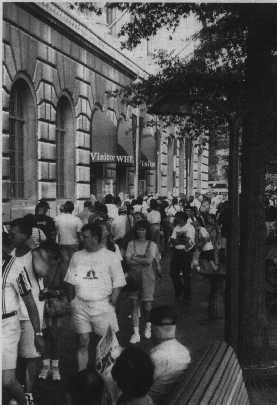
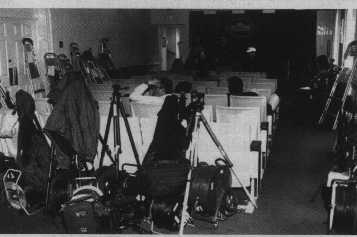
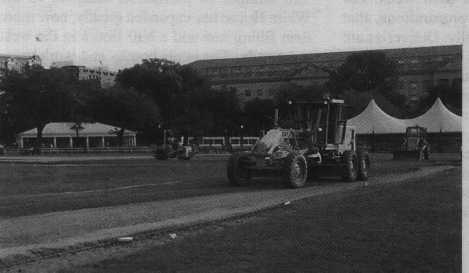
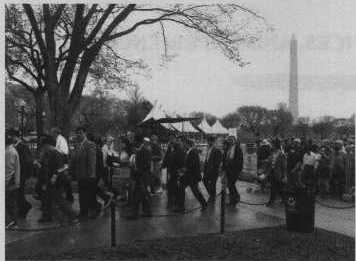
Visitors queue for the White House public tour along the fence.
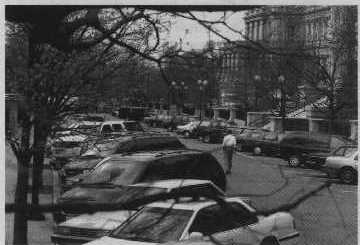
Vehicles parked along West Executive Avenue create a cluttered, rather than a dignified, appearance for the home and office of the president
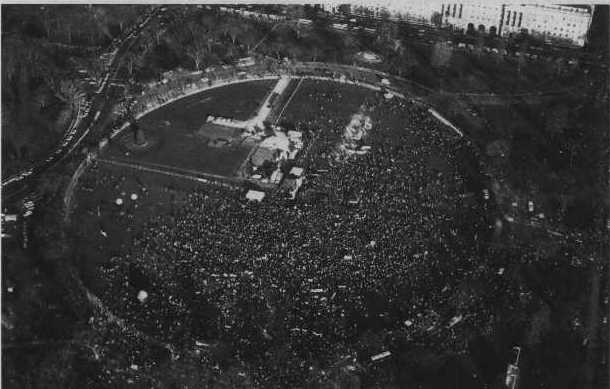
A large First Amendment demonstration on the Ellipse shows the type of use this portion of President's Park receives. The Pageant of Peace site is still being dismantled in the top left of the picture. Portable toilets flank the Ellipse roadway on the top right. Staff parking around the Ellipse has been removed for the day. This photo predates the building of the Ellipse visitor pavilion in 1994.
Public Access to the White House
Historical Overview
Visitor Use. Services. and Experience
increased despite two additional presidential assassinations, creating security problems and safety concerns. Celebrations, demonstrations, and official events continued to be held at the house and on the grounds, including state receptions, Fourth of July celebrations, gatherings of military, religious and political groups, and public protests.
Current Visitation and Projected Trends
is also expected to grow. Approximately 20 million visitors came to Washington in 1995 (visitation varied from l8.5 to 20.4 million between 1987 and 1996; Washington, D.C., Convention and Visitors Association, 1996). Visitation is projected to increase to 21 to 22 million visitors in the next five to eight years. With this growth, it is expected that more and more visitors will only go to the visitor center because they cannot be accommodated on public White House tours. Thus, the visitor center will play an increasingly important role in providing White House related experiences.
Who Visits the White House and President's Park?
*Group size -- Most commonly, groups consisted of two (31%) or four (18%) people; but varied throughout the year. The most common group size was two in the fall (45%) and spring (30%), and four in the summer (24%).
*Group type Families were the most common group type (54%) taking the tour. During summer 64% of the visitor groups were families, compared to 51 % in spring and 49% in fall.
*Age -- The most common visitor ages were 36 45 (24%), followed by children 15 years or younger (21%). During summer children 15 years or younger were the most common (30%); during fall this percentage fell to 10%.
*Number of times on the White House tour -- Eighty percent of the visitors were on their first tour, while 17% had taken the tour two to four times. Slightly more spring visitors (83%) were on their first tour than fall (80%) or summer (79%) visitors.
|
|
|||
| YEAR | CONGRESSIONAL TOURS | PUBLIC TOURS | TOTAL TOUR VISITATION |
| 1987 | 329,000 | 749,000 | 1,078,000 |
| 1988 | 299,000 | 791,000 | 1,090,000 |
| 1989 | 247,000 | 814,000 | 1,061,000 |
| 1990 | 243,000 | 847,000 | 1,090,000 |
| 1991 | 198,000 | 742,000 | 940,000 |
| 1992 | 241,000 | 824,000 | 1,065,000 |
| 1993 | 258,000 | 837,000 | 1,095,000 |
| 1994 | 256,000 | 869,000 | 1,125,000 |
| 1995 | 223,000 | 808,000 | 1,031,000 |
| 1996 | 255,000 | 814,000 | 1,069,000 |
Visitor Use, Services, and Experience
The Visitor Experience
Visitor Orientation and Information
Visitor Center
THE AFFECTED ENVIRONMENT
the survey, 64% thought the overall quality of services and facilities was very good, 34% rated them as good, and 2% as average. Items that were rated included directional and safety signs, prompt and courteous service, cleanliness of visitor center facilities, quality of audiovisual programs, quality of brochures/ maps and exhibits, quality of recreational opportunities, and quality of educational opportunities (Univ. of Idaho, CPSU 1995).
Interpretation/Education
White House Tours
Public tours are between 10 A.M. and noon Tuesday through Saturday. From March to Labor Day public tour visitors pick up free tickets (indicating a specific tour time) on the day of the tour at the visitor center. Tickets are available beginning at 7:30 A.M. and are distributed on a first-come, first-served basis. Because tickets are limited, many visitors are turned away during the peak season.
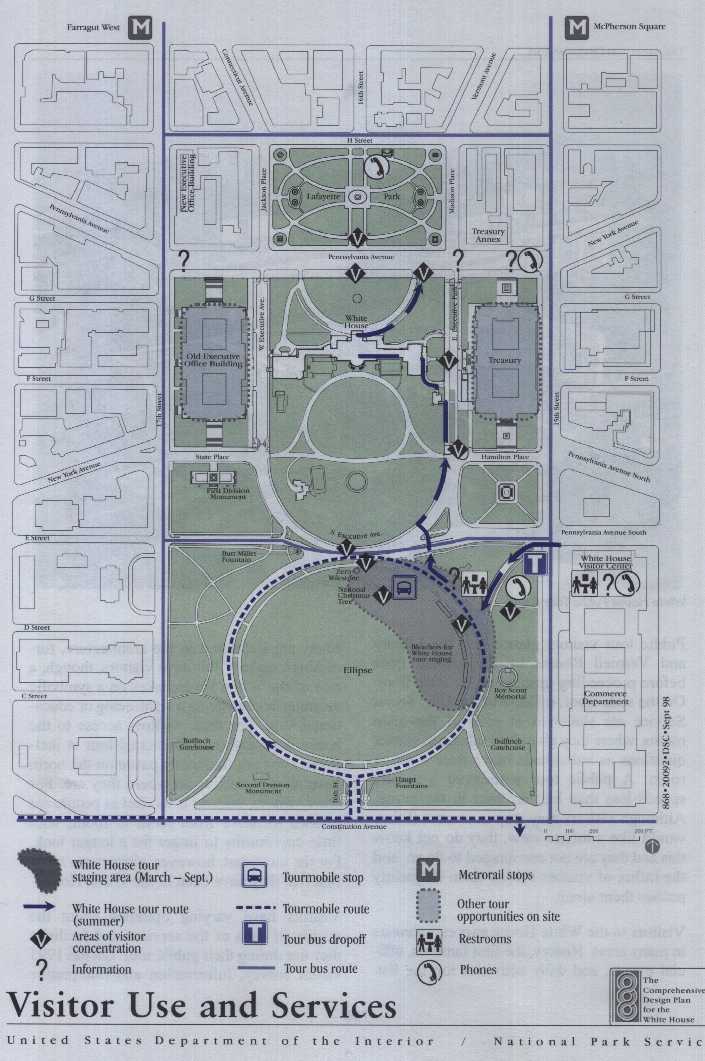
THE AFFECTED ENVIRONMENT
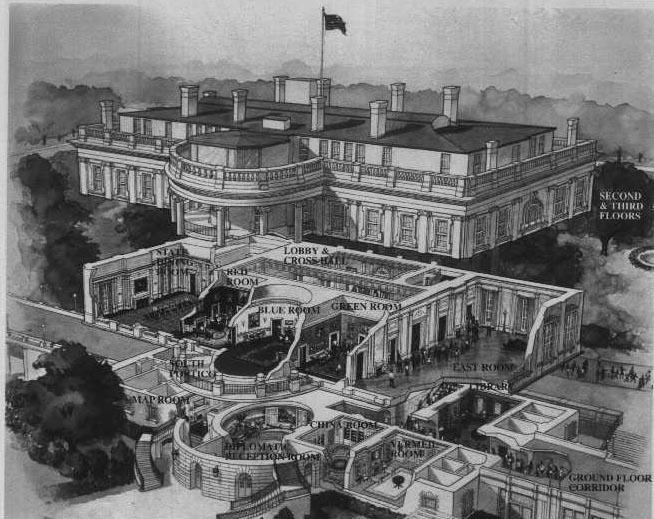
White House Public Tour Route
Visitor Use. Services, and Experience
services were rated as good or very good (maps/brochures, 74%; NPS ranger assistance, 72%; and the NPS information kiosk, 70%). The White House roosts guides were rated as good or very good by 64% of the visitors. Educational sales in the visitor center were rated as good or very good by 63% (Univ. of Idaho, CPSU 1995).
Other Tours and Interpretation
Site Amenities
Recreations
Noise
Community Noise Levels
Community noise levels fluctuate continually, with many factors affecting how humans perceive sound. These factors include background noise, the actual noise level associated with an activity, the frequency of noise, the length of time exposed, and changes in noise levels
THE AFFECTED ENVIRONMENT
during exposure. Noise levels are measured in A-weighted decibels (dB(A)).
Background (Ambient) Noise Levels
Regulations
THE AFFECTED ENVIRONMENT
|
|
||||
| EVENT | LOCATION | FREQUENCY | DESCRIPTION | ATTENDANCE PER EVENT |
| Lafayette Park / Pennsylvania Avenue | ||||
| 1st Amendment Demonstrations Ex.: | Southeast quadrant of park | . | . | . |
| * National Smoke-in | " | July 4 | Hemp legalization rally | 1,000 |
| * Nuclear Vigil | " | Continuous | Protesting nuclear arms | 3 to a maximum of 3,000 |
| Presidential Inaugural Parade | Pennsylvania Avenue (Lafayette Park is used for media stands, event staging, and other reviewing stands) | Every four years | Preparations begin in November; facilities are removed by the end of February, with restoration taking place through March. | 250,000 to 500,000 |
| White House and Grounds | ||||
| State Dinners | White House state rooms | 6-10 times per year | Held in honor of visiting heads of state | 130 |
| State Arrivals | White House south grounds and Ellipse | 6-10 times per Year | Formal military parade on south lawn with 21-gun salute. | 4,000 |
| Easter Egg Roll | White House south grounds and Ellipse | Monday following Easter | Children six years of age and younger, accompanied by adults. Lines form on or around the Ellipse, with activities provided on the Ellipse and the White House grounds. Free, timed tickets are provided for entry to the White House grounds; additional activities are provided on the Ellipse. | 25,000 |
| Spring and Fall Garden Tours | White House grounds | Annually-Second or third weekend in April and October | Includes tours of both the White House and grounds. | 25,000 |
| Candlelight Tours | White House state rooms | Annually-Three evenings between Christmas and New Year's Day. | Tours of the ground and state floors with seasonal decorations | 33,000 |
|
Presidential/First Family Social Events |
South grounds | 5 - times per year | Events such as congressional barbecues; some-times includes tents and stage construction | 1,200 to 5,000 |
| Tapings for TV Broadcast | East Room | 3-4 times per year | Tapings of special presentations for broadcast on public TV | 200 |
| Ellipse | ||||
|
First Amendment Demonstrations * Right to Life March |
Ellipse | January 22 | Roe v. Wade protest | 125,000 |
| Pageant of Peace | Northeast quadrant | 3 weeks in December | Northeast quadrant of Ellipse is used as a stage for the lighting of the National Christmas Tree and other holiday events. Construction begins in October; site restoration Until May | 270,000 |
| George Washington University Graduation | Western half of Ellipse and part of southeast quadrant | mid-May | Chairs, stages, and event infrastructure are erected | 20,000 |
| Military District of Washington Twilight Tattoo | Northeast quadrant | Every Wednesday evening during summer | U.S. Army presentation of ceremonial troops marching and performing drills. | 10,000 |
| Parades on Constitution Avenue | Southern portion of the Ellipse | Four times a year (St. Patrick's Day, Cherry Blossom, Safety Patrol, and Fourth of July) | Bleachers and reviewing stands are placed along Constitution Avenue. | 20,000 to 100,000 |
Special Events
White House Events